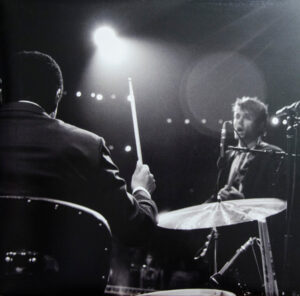Nerd-torial: The dithering dilemma – Why our ear sometimes beats theory
Welcome back, dear audio nerds! In the last Nerd-torial, we introduced you to our high-precision vinyl recording process, from 32-bit integer recording with the RME ADI-2 Pro FS to the internal 64-bit float processing in Sound Forge Pro 15. We learned why this extreme computing accuracy is crucial to preserve the “aura” of our records without loss.
But at the end of every mastering process is a tricky decision: reducing the bit depth for export. And this is where dithering comes into play – a technique that seems contradictory at first glance, but is essential for sound quality. And as we found out at Mother Earth Radio, it sometimes works differently than theory predicts.
Dithering: The small noise that makes big differences
Remember: our audio data is processed internally with an incredible 64-bit floating point. This is a dynamic range that is far beyond anything the human ear or even the best studio technology can capture. If we now reduce this data to 24 bits (the standard for Hi-Res FLAC) for export, quantization errors occur mathematically. These errors are not harmless rounding differences; they manifest themselves as unmusical, harsh distortions that can sound like digital “chirping” or “tearing off”, especially in quiet passages.
Dithering is the solution: we add a tiny, random noise to the signal. This noise is so small that it is barely audible. But it has a magical effect: it randomizes the quantization errors and converts them into a much more pleasant, analogue-sounding noise. The result: a clearer, more detailed and more natural sound, even if we reduce the bit depth.
The dithering duel: POWR 1 (standard) vs. POWR 3 (noise shaping)
There are different methods of dithering. At Mother Earth Radio, we had the choice between POWR 1 (a standard dithering without pronounced noise shaping) and POWR 3 (with noise shaping).
Conventional theory often states that noise shaping (as in POWR 3) is advantageous. Why? It shifts the energy of the dithering noise from the frequency ranges where our hearing is most sensitive (the mids) to the higher, less sensitive frequencies. The overall noise level tends to be even higher – but it is concentrated where we should perceive it least. For classical music in particular, with its extremely quiet passages, this has often been advertised as the superior method for keeping the finest details in the mid-range free of noise.
The practical shock: John Mayer and the acoustic guitar
Naturally, we wanted to put this theory to the test ourselves. Our initial tests with dense, complex pieces (such as the John Mayer Trio) showed little audible difference between the dithering methods. The music was so “full” that it effectively masked the dithering noise.


But then came the litmus test: a solo acoustic recording of John Mayer – just his voice and a guitar. Here, with this transparent, intimate material, a clear difference suddenly became apparent , in favor of the standard dithering (POWR 1)!
What we heard was an undesirable “sharpness” in the high guitar registers and with concise vocals when noise shaping (POWR 3) was applied. The original sounded much closer to the master WAV file with POWR 1. The theory that noise can be “hidden” in the high frequencies reached its limits here.
Why our ear sometimes beats theory: The hi-res factor
This observation raises important questions and confirms our skepticism about sweeping statements in the audio world:
- Human hearing is more complex: the assumption that “nothing is heard” above 20 kHz or that “you can do whatever you want with it” is too simplistic. Even if we do not perceive frequencies above 20 kHz as pitch, they can subtly influence the timbre, the sense of space, the precision of transients and the overall “naturalness” of the sound image. A concentration of noise in these regions may well manifest itself as an unpleasant harshness or sharpness in the perceived spectrum.
- Noise shaping and hi-res audio: Many noise shaping algorithms were developed and optimized in an era when 44.1 kHz and 48 kHz were the norm. At our extremely high sample rates of 192 kHz (and above in processing), where a much wider frequency range beyond 20 kHz exists, the effects of shifted noise can have a different, and possibly negative, impact. It seems that the algorithms in these regions sometimes produce artifacts that our “whole person” does perceive.
The Mother Earth Radio Dithering conclusion
Based on our extensive listening tests and in-depth research, we have opted for standard dithering (without aggressive noise shaping) at Mother Earth Radio. It may not theoretically offer “that last bit of midrange noise immunity”, but it delivers a more consistent, natural and, above all, unobtrusive sonic result for the full range of our vinyl material – from dense rock recordings to delicate acoustic music.
It shows once again: while theory gives us a valuable guideline, in the end it is the trained ear of the sound engineer that makes the final decision. At Mother Earth Radio, we trust our ears to bring the “aura of music” to you as authentically as possible.
Florian Reiterer is an audio engineer and musician with a passion for high-resolution audio. He founded Mother Earth Radio to explore and deliver the best possible listening experience.
…see full Bio

Leave a Reply
You must be logged in to post a comment.